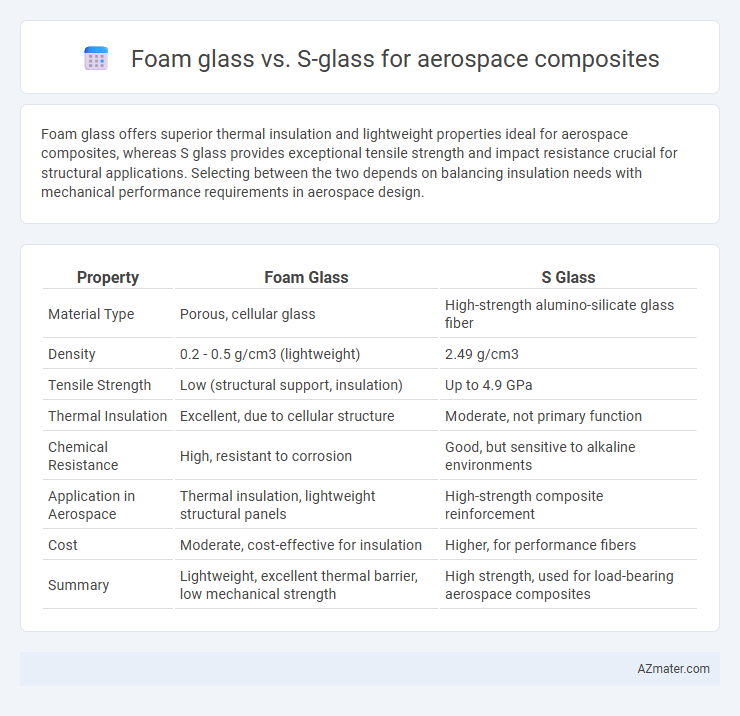Foam glass offers superior thermal insulation and lightweight properties ideal for aerospace composites, whereas S glass provides exceptional tensile strength and impact resistance crucial for structural applications. Selecting between the two depends on balancing insulation needs with mechanical performance requirements in aerospace design.
Table of Comparison
| Property | Foam Glass | S Glass |
|---|---|---|
| Material Type | Porous, cellular glass | High-strength alumino-silicate glass fiber |
| Density | 0.2 - 0.5 g/cm3 (lightweight) | 2.49 g/cm3 |
| Tensile Strength | Low (structural support, insulation) | Up to 4.9 GPa |
| Thermal Insulation | Excellent, due to cellular structure | Moderate, not primary function |
| Chemical Resistance | High, resistant to corrosion | Good, but sensitive to alkaline environments |
| Application in Aerospace | Thermal insulation, lightweight structural panels | High-strength composite reinforcement |
| Cost | Moderate, cost-effective for insulation | Higher, for performance fibers |
| Summary | Lightweight, excellent thermal barrier, low mechanical strength | High strength, used for load-bearing aerospace composites |
Introduction to Aerospace Composite Materials
Aerospace composite materials combine high-strength fibers and lightweight matrices to enhance performance and durability in extreme environments. Foam glass offers excellent thermal insulation and low density, making it suitable for weight-sensitive structures requiring thermal stability. S glass fibers provide superior tensile strength and impact resistance, optimizing mechanical performance in aerospace composite applications.
What is Foam Glass?
Foam glass is a lightweight, porous material made from crushed glass fused into a foam-like structure, offering exceptional thermal insulation and compressive strength ideal for aerospace composite applications. It stands out for its non-combustible nature, chemical resistance, and ability to withstand extreme temperatures, making it a reliable choice for aircraft components requiring durability and lightweight properties. Compared to S glass, which is a high-strength fiberglass used for structural reinforcement, foam glass primarily serves as an insulating core material rather than a load-bearing fiber.
What is S Glass?
S Glass, a high-strength fiber reinforced composite material, offers superior tensile strength and thermal stability compared to traditional fiberglass, making it ideal for aerospace applications. Foam glass, however, serves primarily as a lightweight, insulating material with excellent thermal and acoustic properties but lacks the mechanical strength required in structural aerospace composites. The critical distinction lies in S Glass's ability to enhance composite durability and load-bearing capacity, while foam glass excels in insulation and weight reduction.
Physical Properties: Foam Glass vs S Glass
Foam glass exhibits low density and excellent thermal insulation, making it highly effective for lightweight, heat-resistant aerospace components. S glass offers superior tensile strength and impact resistance, ideal for structural composite materials needing high mechanical performance. The choice between foam glass and S glass depends on balancing insulation properties with mechanical strength requirements in aerospace applications.
Mechanical Performance Comparison
Foam glass exhibits low density and excellent thermal insulation but generally falls short in tensile strength and impact resistance compared to S-glass, a high-performance fiberglass known for superior mechanical properties. S-glass delivers enhanced tensile strength (up to 700 MPa) and modulus of elasticity (~86 GPa), making it ideal for aerospace composites requiring high load-bearing capacity and durability. The mechanical performance of S-glass outperforms foam glass in fatigue resistance and fracture toughness, critical factors for aerospace structural applications.
Weight and Density Considerations
Foam glass exhibits a significantly lower density compared to S glass fibers, with typical foam glass densities around 0.1 to 0.3 g/cm3 versus S glass densities near 2.5 g/cm3, making foam glass advantageous for weight reduction in aerospace composites. The porous, cellular structure of foam glass enables superior insulation and lightweight properties, while S glass offers higher tensile strength but at a greater mass. Weight-sensitive aerospace applications often prioritize foam glass composites when minimizing density is critical, balancing mechanical performance and structural demands.
Thermal and Fire Resistance
Foam glass and S glass offer distinct advantages in aerospace composites due to their thermal and fire resistance properties; foam glass provides excellent insulation with low thermal conductivity and inherent non-combustibility, making it ideal for thermal management and fire protection. S glass, a high-strength alumino-silicate fiber, exhibits superior thermal stability and resists deformation at elevated temperatures, enhancing composite structural integrity under fire exposure. Selecting between foam glass and S glass depends on the specific aerospace application's thermal insulation needs versus mechanical performance in fire-prone environments.
Cost-Effectiveness in Aerospace Applications
Foam glass offers superior cost-effectiveness in aerospace composites due to its lightweight properties and excellent thermal insulation, which reduce fuel consumption and maintenance costs over time. S glass provides high tensile strength and durability but comes at a higher material and processing cost, making it less economical for large-scale aerospace applications. Evaluating total life-cycle costs reveals foam glass as a more budget-friendly option without significantly compromising performance.
Environmental Impact and Sustainability
Foam glass offers superior environmental benefits in aerospace composites due to its recyclability, non-toxicity, and energy-efficient production from recycled glass materials, significantly reducing carbon footprint compared to synthetic fibers. In contrast, S glass, while providing high strength and thermal resistance, involves energy-intensive manufacturing processes and generates hazardous waste, raising sustainability concerns. The use of foam glass enhances circular economy practices in aerospace by enabling lightweight, durable components with minimal environmental deterioration over their lifecycle.
Best Applications: When to Use Foam Glass or S Glass
Foam glass is ideal for thermal insulation and lightweight structural components in aerospace, where high compressive strength and thermal resistance are crucial. S glass excels in applications requiring superior tensile strength, impact resistance, and durability, making it suitable for load-bearing components and aerodynamic surfaces. Selecting foam glass benefits insulation-related aerospace parts, while S glass is preferred for structural reinforcements and high-stress composite applications.

Infographic: Foam glass vs S glass for Aerospace composite
 azmater.com
azmater.com